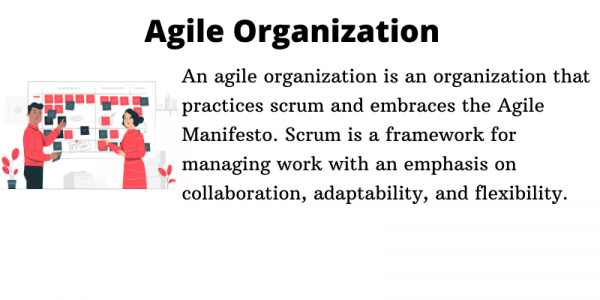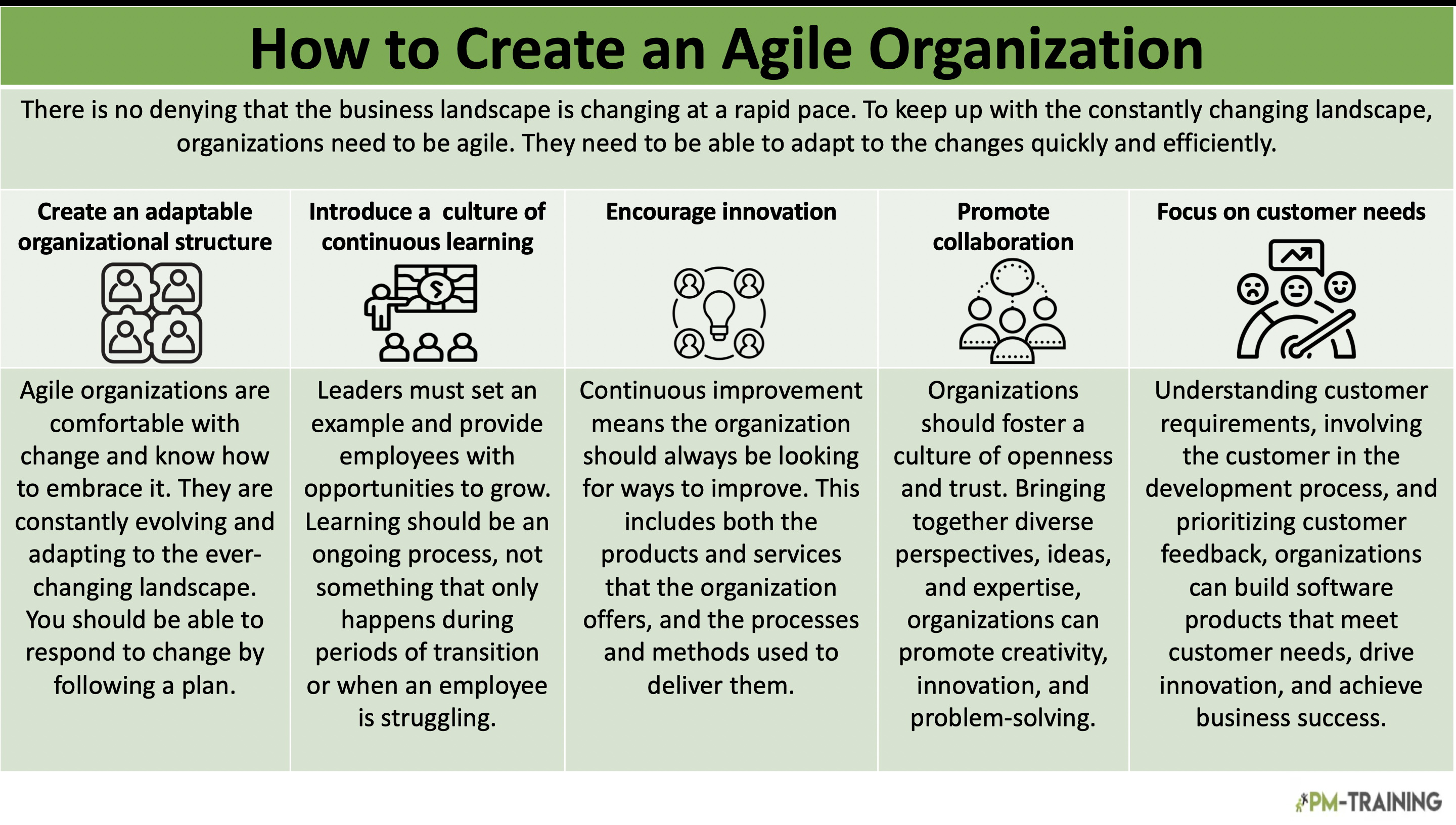An agile organization is an organization that practices scrum and embraces the Agile Manifesto. Scrum is a framework for managing work with an emphasis on collaboration, adaptability, and flexibility. Scrum teams are self-organized and cross-functional. They are typically small, with around 10 members. This type of organization is designed to be able to respond quickly to change and is characterized by short iterations, or sprints, and a backlog of work that is prioritized by the team.
Agile organization is a term that is thrown around a lot in business circles, but what does it mean? It is an organization that can adapt and change quickly in response to new information or circumstances.
The term “agile” comes from the software development process known as scrum, which is an iterative and incremental approach to software development. In Scrum, teams work in short cycles, or sprints, to deliver a product or service. The aim is to be able to respond quickly to change and to deliver value to customers early and often.
These agile organizations are able to achieve their success due to their ability to be flexible and adaptable. They are able to rapidly respond to changes in the market or in customer needs, and they are able to adjust their workflows and processes accordingly. This flexibility allows them to stay ahead of the competition and continue to grow and succeed.
Agile Manifesto
The Agile Manifesto is a set of four guiding principles for software development. It was first proposed in 2001 as a way to address the problems with traditional, waterfall-style development methods. When implementing agile principles in an organization, there are a few core values that need to be taken into account. These values are:
Individuals and interactions over processes and tools
Working software over comprehensive documentation
Customer collaboration over contract negotiation
Responding to change by following a plan
These four principles have helped many software development teams to improve their process and deliver better quality software. By adhering to these values, organizations can create a more agile and efficient workplace. If you’re thinking of adopting an agile development process for your team, the Agile Manifesto is a great place to start.

Why are Agile Organizations important for the Future?
There is no denying that the business landscape is changing at a rapid pace. To keep up with the constantly changing landscape, organizations need to be agile. They need to be able to adapt to the changes quickly and efficiently.
Agile organizations are those that can make changes quickly and efficiently. They can adapt to the changes in the landscape quickly. This is why agile organizations are so important for the future.
While there are many benefits of being an agile organization, some of the most important benefits include being able to respond to changes quickly, being able to innovate quickly, and being able to adapt to the changes in the landscape quickly.
Benefits of Agile in an Organization
When used properly, agile can help organizations to achieve their goals more efficiently and effectively.
There are many benefits of using agile in an organization. Some of the most notable benefits include:
- Increased flexibility and responsiveness to change
- Improved communication and collaboration Among team members
- Greater customer satisfaction
- Faster delivery of results
- Improved overall quality of the final product
Traits of Agile Organizations
An agile organization is an organization that is characterized by having short development cycles, close communication between teams and customers, and a flexible approach to change.
These types of Organizations are typically faster and more responsive to change than traditional organizations.
There are many different ways to be an agile organization, but there are a few general aspects that are common to most organizations that are agile.
- Agile organizations have short development cycles. This means that they are constantly releasing new versions of their products and services, and they are always trying to improve their offerings.
- Agile organizations have close communication between teams and customers. This communication helps to ensure that everyone is on the same page and that the customer’s needs are being met.
- Finally, agile organizations have a flexible approach to change. This means that they are willing to adapt their plans and processes as new information arises, and they are not afraid
How to create an Agile Organization

There is no single silver bullet for creating an agile organization, but there are a number of key practices that can help. From adaptable structure and culture to continuous learning and experimentation, these practices can help you create an organization that is able to quickly adapt to change. While there is no one-size-fits-all solution, here are a few practices that can help you create an agile organization:
Create an adaptable organizational structure
Be open to change. Agile organizations are those that are comfortable with change and know how to embrace it. They are constantly evolving and adapting to the ever-changing landscape. You should be able to respond to change by following a plan.
Encourage a culture of continuous learning
In order to encourage a culture of continuous learning, leaders must set an example and provide employees with opportunities to grow. Learning should be seen as an ongoing process, not something that only happens during periods of transition or when an employee is struggling.
Encourage experimentation and innovation
Continuous improvement means that the organization should always be looking for ways to improve. This includes both the products and services that the organization offers, as well as the processes and methods used to deliver them. Take the courage to the willingness to take risks and experiment. This is essential for innovation.
Promote communication and collaboration
For example, transparency means that information should be shared openly and freely within the organization. This allows for better decision-making and collaboration.
Focus on customer needs
Customer focus means that the organization should be focused on delivering value to the customer. This ensures that the organization is always meeting the needs of the customer.
Examples of Agile organizations in the world
There are many different types of agile organizations in the world. Some examples include start-ups, small businesses, and even large corporations.
Start-ups are often considered to be the most agile type of organization. This is because they are typically small, nimble, and quick to adapt to change. This allows them to rapidly respond to customer needs and quickly iterate on their products and services.
It is important to mention that Large corporations can also be agile. This is because they often have the resources and the manpower to quickly respond to customer needs:
For example:
- IBM
- Microsoft
- Procter & Gamble
As agile organizations are those that are able to rapidly adapt to changing conditions and demands. They are typically characterized by flat hierarchies, flexible workflows, and a focus on customer needs. Some well-known examples of popular agile organizations can include:
- Netflix
- Amazon
- Spotify
- Apple
As you can see, they are very well known, but it is important to mention that if you realize, they are all modern.
FAQs
What is an Agile Organization?
Agile organizations are those that embrace the principles of agility in everything they do. They are characterized by a focus on customer satisfaction, continuous delivery of value, and a willingness to embrace change. They are also typified by a flat organizational structure, self-organizing teams, and a focus on collaboration.
What is the Agile Manifesto?
It is a statement of principles for software development that emphasizes collaboration, customer satisfaction, and flexibility. It was created by a group of software developers who were dissatisfied with traditional development methods and it has had a major impact on the software development industry and has helped to shape the way we develop software today.
Why are Agiles Organizations important in this Future?
An agile organization is one that is able to rapidly adapt to change. It is flexible, responsive, and has a culture of innovation. This type of organization is better equipped to deal with the challenges of the modern world and is more likely to be successful in the long term.
What are the main benefits of Agile in an organization?
It can increase efficiency and effectiveness, brings greater flexibility, improves communication, enhanced teamwork, and increased customer satisfaction
